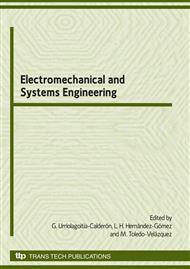p.73
p.81
p.89
p.95
p.103
p.109
p.117
p.121
p.127
Tensile Strength of Fibers Extracted from the Leaves of the angustifolia Haw Agave in Function of their Length
Abstract:
This paper presents the results of the tensile strength evaluation of the fibers of the leaves of the agave species angustifolia Haw. The purpose of the study was to determine the mechanical behavior of the fibers under the following test conditions: (1) in fibers of the agave leave as a whole; (2) in three different longitudinal sections of the fiber: base, center and tip; (3) with a variable length and a constant test speed and (4) with a constant length and a variable test speed. The experiment began with the classification of the agave leaves by level; later the fibers were extracted through the process of retting; next the fibers were stabilized at a temperature of 20 ºc ± 2 ºc and at a relative humidity of 65 %; then the tensile tests were carried out. Finally, the Ultimate Tensile Strength (UTS), the Modulus of Elasticity (ME) and the Ultimate Strain (%) were evaluated. The results show that the fibers exhibit viscoelastic behavior and their characteristics are within the range of other similar vegetal fibers, which are currently being used by industry in the manufacture of new composites.
Info:
Periodical:
Pages:
103-108
Citation:
Online since:
August 2009
Price:
Сopyright:
© 2009 Trans Tech Publications Ltd. All Rights Reserved
Share:
Citation:


